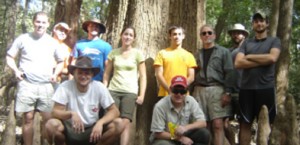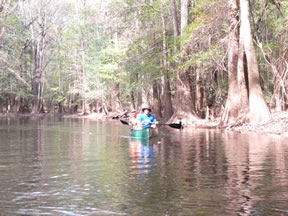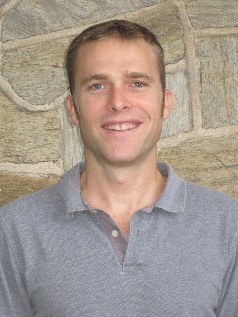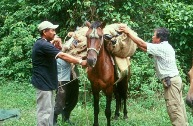What do you get when you give academically motivated and naturally curious students a challenge? Well, if they are NC State students, you’ll get the opportunity to see the best of the best.
The NC State Department of Forestry and Environmental Resources encourages our students to participate in their own professional development by becoming active in professional societies and attending conferences. Over the past several years, the department has encouraged participation in the Society of American Foresters (SAF) national convention by subsidizing the students’ cost of attendance. Through the direction of their faculty advisor, Joe Roise, the NC State Student Chapter of SAF has a long tradition of organizing a pre-conference Wilderness Leadership Excursion in the area where the convention is being held.
This year, the SAF national convention was held in Charleston, SC, and the Wilderness Leadership Excursion took place in Congaree National Park. “The national park is 24,180 acres and is one of the newest parks,” explained Matthew Haunsperger, SAF Student Chapter President. “The creek is a black water system that flows through the center of the park and is lined with cypress, water tupelo, swamp laurel oak, and some of the largest loblolly pines in the nation.” Matt led, with eight other students and Joe Roise, a canoe trip down Cedar Creek through the park and onto the Congaree River.
The group met many obstacles along the way – literally. “The water level was very low for October,” said Dr. Roise. “There were so many downed trees across the creek that we had to carry the canoes more than we had expected.” Apparently, a water moccasin thought it would add a little more excitement to the mix at one point. Each challenge, however, was met and dealt with.
“When our destination was reached 27 miles and 4 days later, we ventured to Charleston, to meet with the rest of our chapter. For many, it was their first convention and one not to forget,” said Matt. He explained that it was particularly relevant for the students to attend a southeastern conference, because they are currently studying the silviculture of that region. “The seminars allowed us to see the research and job opportunities in our area. The insight inspired students to see what paths they can follow after completion of their education,” reflected Matt.
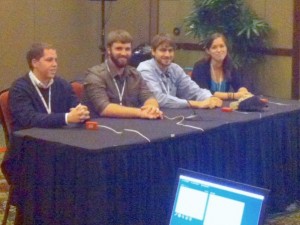
NCSU SAF Student Chapter 2013 Quiz Bowl Team from left to right: Thomas Harris, Matthew Haunsperger, Alex Thompson, Courtney Johnson
“One of the best parts about these trips,” Dr. Roise revealed, “is getting away from campus. I get to know them, not just as my students, but as people. They are a great group, and getting to know them as people is a privilege.”
Eighteen NC State students in all participated in the 2013 SAF convention, which included a valiant effort by our Quiz Bowl Team. When possible, the department and college hosts an alumni luncheon during the convention, and this year was not an exception, since it was, relatively speaking, in our own backyard. We had a record attendance of 75 alumni, friends and students for the luncheon, which featured an update on the College of Natural Resources’ strategic planning progress by Dean Mary Watzin.
Back at school now and the weather much colder, the students who attended the wilderness excursion and/or the convention have their heads the books and their eyes on the prize of a degree in a field that they love. But their education has been enhanced by the depth of their experiences, and the breadth of their commitment keeps us in awe.
Excerpts above and quotes below from an article in The Trail Blazer, Newsletter of the Appalachian Society of American Foresters – Winter 2013-14 Edition
In their own words – about attending the national convention:
In October I had the chance to attend the Society of American Foresters national convention in Charleston, SC. This was my first time attending the convention and I believe it was a great experience. While at the convention I was able to meet with other forestry students from around the United States. It was interesting to learn about how different colleges are teaching forestry. I also had the opportunity to meet forestry professionals from around the country and learn about all the different types of jobs in the U.S. All in all it was a great experience and I hope to attend in future years. ~Anthony Moore, Forest Management, NC State
This year’s Society of American Foresters convention in Charleston SC introduced me for the first time to forestry science on a national level. Each day I interacted with outstanding students, professors, and professionals in natural resource management from across the country and around the world. The most memorable times were catching up with speakers after their presentations to discuss their topic and speaking with students and representatives from different universities offering graduate degree programs. The time to speak with leading researchers was wonderful; it gave me a personal link to the research they presented. Before the convention I was unable to make the connection between scientific article describing research projects I had read and the individuals carrying out the research. Furthermore, the representation of numerous graduate degree programs in forestry and other natural resource fields afforded me the chance to think about my future and how I will incorporate graduate studies. ~Thomas Harris, Forest Management, NC State
The most memorable part about going to the SAF National Convention is the people I meet. The convention presents so many great opportunities to network with professionals and students as well. Meeting students from around the country opened my eyes to the differences between programs, like for instance; UC Berkeley has way more women in their forestry program and very few men. I also had the chance to mingle with the other women in forestry careers, including SAF President, Mrs. Joann Cox. I met people from all four corners of the country and I can’t wait for next year’s convention to have the chance to get to know them better. ~Courtney Johnson, Forest Management, NC State
Click the image below to see the photo gallery from the trip. Problem viewing the album?
 |
| Photo Gallery – 2013 NCSU SAF Student Chapter Wilderness Expedition in Congaree National Park and SAF Convention |


